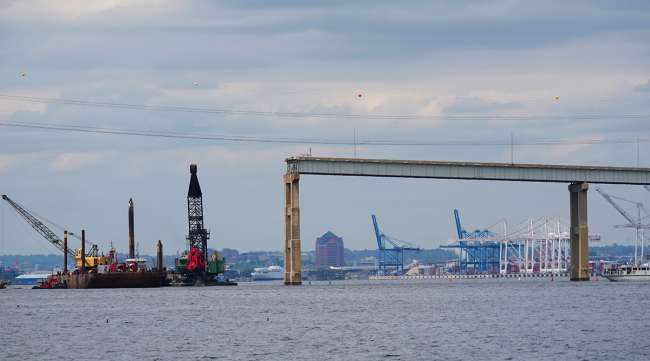Senior Reporter
House to Examine Baltimore Bridge Collapse May 15

[Stay on top of transportation news: Get TTNews in your inbox.]
WASHINGTON — A House panel this month will review concerns and challenges associated with rebuilding efforts at the Port of Baltimore, where crews are removing debris to implement infrastructure upgrades and ultimately rebuild the Francis Scott Key Bridge.
The hearing of the Transportation and Infrastructure Committee, scheduled for May 15, is expected to examine the cause of the March 26 collapse of the once-bustling bridge as well as actions taken by local, state and federal agencies and the private sector to restore connectivity along the commercial and commuter corridor.
Specific to the Port of Baltimore’s core mission of facilitating the flow of freight in the Northeast, policymakers will focus on operational and funding needs and potential oversight of agencies, according to committee aides.
The House hearing will take place nearly two weeks after members of a funding panel surveyed the port to assess the damage. House Appropriations Committee leaders and senior panel members who traveled to the site are tasked with considering emergency aid. After their visit on May 2, the lawmakers suggested that Congress demonstrate renewed attention and oversight for the afflicted area.

Cole
Appropriations Committee Chairman Tom Cole (R-Okla.) and his colleagues issued a joint statement: “As appropriators and local community leaders, it is vital that we understand the magnitude of this situation and determine the best path forward. In the near term, we are focused on recovery efforts, rebuilding costs and ensuring port operations are fully resumed.”
“We continue to send our condolences to the families who’ve suffered immeasurable loss and are grateful to the first responders who quickly responded in the face of tragedy. We remain committed to navigating this situation together,” the House appropriators said. Joining Cole for the short trip from Capitol Hill to Baltimore were committee ranking member Rep. Rosa DeLauro (D-Conn.), Transportation, Housing and Urban Development, and Related Agencies Appropriations Subcommittee Chairman Steve Womack (R-Ark.) and the subcommittee’s ranking member, Rep. Mike Quigley (D-Ill.), among others.
RELATED: Congressional Support Builds for Baltimore Aid

Moore
Maryland Gov. Wes Moore (D), who accompanied the federal lawmakers during the tour of the area, continues to press for emergency funding. “The collapse of the Key Bridge isn’t just about Maryland — it’s about our country, our people and our economy. Everyone has a role in helping us fully reopen the Port of Baltimore and rebuild the bridge,” said the governor, adding, “Maryland is grateful for the partnership of leaders from both sides of the aisle and all levels of government, who have raised their hands to help us respond to a tragedy of national importance. We can — and we will — rebuild, together.”
Responding to the governor’s call for aid, Maryland’s congressional delegation introduced a bipartisan bill that would facilitate federal funds. The Baltimore BRIDGE Relief Act would assign the federal government full cost of replacing the bridge. A price tag for the project remains unclear. Shortly after the collapse, the Federal Highway Administration provided Maryland $60 million from its emergency account.
Want more news? Listen to today's daily briefing above or go here for more info
After a Senate subcommittee hearing May 2, Transportation Secretary Pete Buttigieg expressed optimism about the Port of Baltimore’s viability. “Our hope is that we’ll be back to normal by the end of May through the amazing work of the Army Corps. And you have the longer-term effort, which is the bridge. We don’t yet have a timeline on the new bridge, but the original one took five years to build, so we know that this is a substantial impact,” the secretary told reporters. “Congress has a sense of urgency, and it’s bipartisan. … I haven’t been counting votes for it, but my belief is that there is a good bipartisan center of gravity for coming through to support this.”
On April 19, the U.S. Department of Transportation convened a meeting with freight stakeholders to assess the collective response at the port. According to background information the department provided: “East Coast port leaders explained how operations at their ports have been impacted by increased throughput from vessels that otherwise would have gone through Baltimore. Those ports have so far been able to accommodate the increase in container, breakbulk, dry bulk and [roll-on, roll-off] traffic, and have worked to make sure Maryland-based truck drivers can access their facilities.”
The Federal Motor Carrier Safety Administration indicated the port remains open for truck transactions, while waterway traffic into and out of the port is suspended until further notice. The National Transportation Safety Board is investigating the collapse of the bridge. Six construction workers were killed after a containership slammed into the structure. According to authorities, their bodies have been recovered.
The body of the sixth victim of the Baltimore bridge collapse has been recovered. pic.twitter.com/lK66hc9qqi — TODAY (@TODAYshow) May 8, 2024



